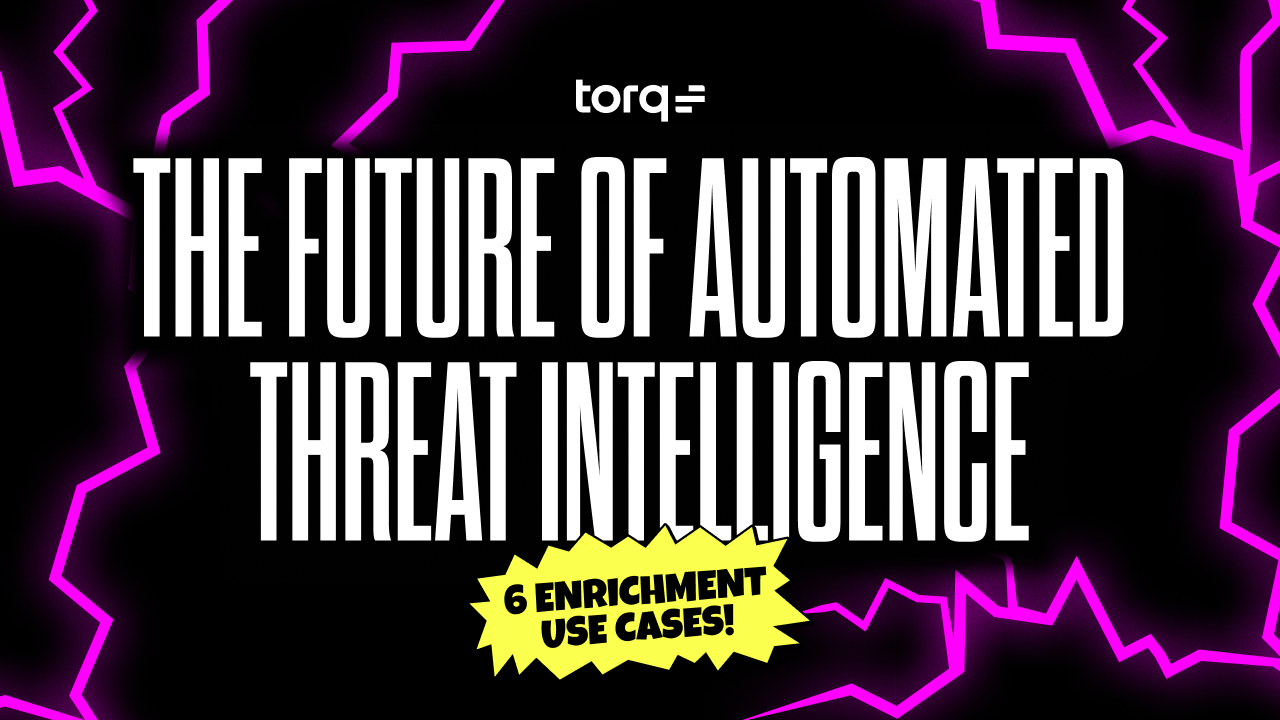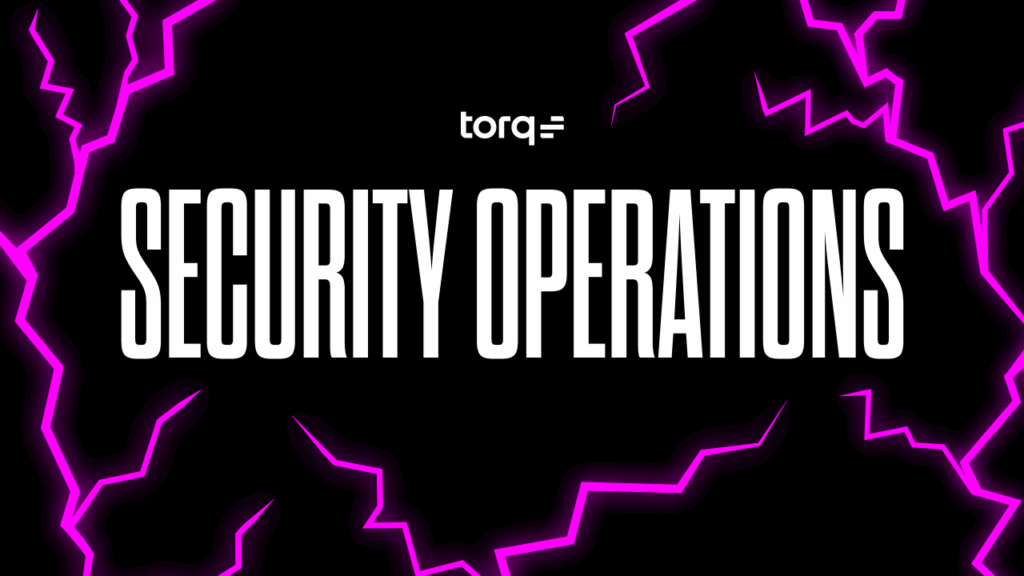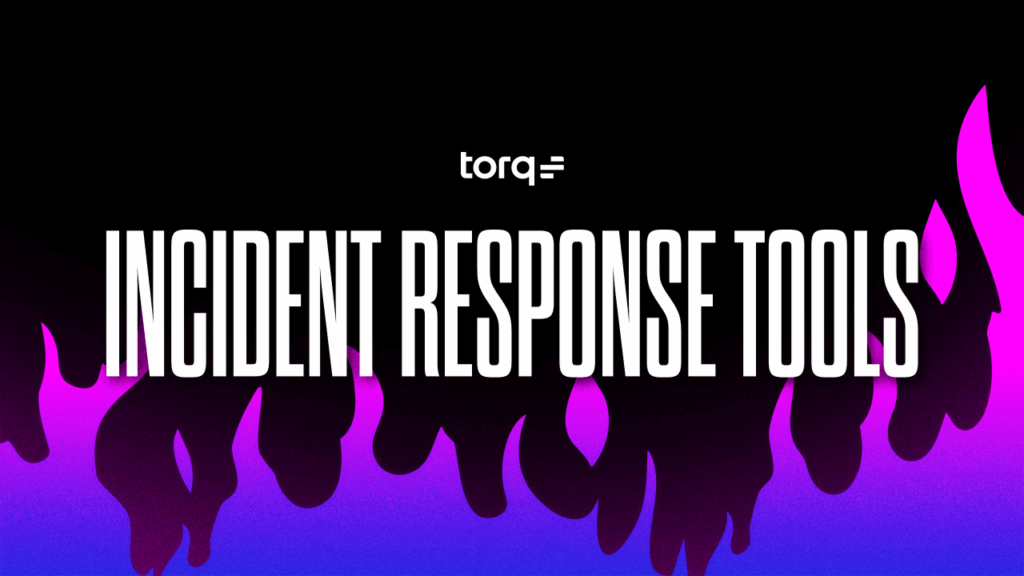Contents
Get a Personalized Demo
See how Torq harnesses AI in your SOC to detect, prioritize, and respond to threats faster.
Cyber threats move fast — your threat intelligence should move faster. But most SOC teams spend more time drowning in false positives and manually correlating threat data than actually responding to real threats.
Automated threat intelligence changes this. With AI-driven automated intelligence, security teams can instantly collect, analyze, and act without sifting through endless alerts and indicators of compromise (IOCs). This shift from playing catch-up to a proactive, automated defense is critical to outpace attackers.
What is Automated Threat Intelligence?
Threat intelligence is the evidence-based collection of information and the observation of the capabilities, techniques, motives, goals, and targets of an existing threat. Simply put, it’s everything that you know about an attacker — actual or potential — based on their motives and how badly they can damage your business assets.
Threat intelligence is not a checklist. It’s a cycle of well-defined processes and operations that involves collecting raw data, cleaning and normalizing it into actionable observables, comparing it to current data to remove duplicates, and then storing it in a structured, human-readable format. That’s a lot of work.
And here’s the reality: SOCs are flooded with data — OSINT feeds, commercial intelligence, SIEM alerts, and internal security logs. Sorting through this manually is incredibly inefficient. Meanwhile, threat actors are evolving, moving faster, and becoming more evasive.
This is where security automation comes in. Instead of relying on analysts to manually collect, correlate, and respond to intelligence data, automated threat intelligence streamlines and enriches alerts, automatically prioritizes threats, and triggers incident response.
The Importance of Automated Threat Intelligence in the SOC
Threat intelligence is the backbone of a SOC, setting apart reactive teams from proactive ones. Here’s why it matters:
- Automated threat intelligence adds important context to threats so teams know what they see.
- It identifies attackers’ tactics, techniques, and procedures (TTPs), giving insight into how threat actors operate.
- Intelligence can enable faster and smarter decision-making, reducing response time and preventing data loss.
- By increasing efficiency, automated intelligence makes it easier to demonstrate ROI and value.
What is Threat Intelligence Enrichment?
Threat intelligence enrichment is the process of adding context to raw security threat data in order to better understand the threat.
Imagine this scenario: You detect a wave of port scans against your servers. You know the IP addresses of the hosts from which the port scans originated, but you don’t know much more than this.
With threat intelligence enrichment, you could immediately gain insights like:
- Where the scanning servers are located
- The operating systems and infrastructure they’re using
- Whether the IPs are linked to known botnets, advanced attackers, or recent global threats
- If these specific scans have been flagged in association with malware campaigns targeting similar organizations
With this enriched intelligence, your SOC can respond with precision and accuracy, blocking known malicious IPs, strengthening defenses against relevant attack vectors, and prioritizing investigations based on risk level.
Of course, you can manage your threat intelligence data manually by correlating and comparing it. That approach, however, is not practical at scale. So, that begs the next question: How can we automate threat intelligence enrichment?
6 Ways to Automate Threat Intelligence Enrichment
1. Enrich Alerts Across Multiple Sources
Security teams need to correlate data from OSINT, intelligence feeds, internal logs, and SIEMs — but they’re stuck manually sifting through inconsistent, raw data. This delays investigations and allows threats to slip through.
Torq Hyperautomation™ automatically collects and correlates threat intelligence across all sources, filtering out false positives and providing actionable insights. Torq ingests, correlates, and enriches raw threat intel in real time, prioritizing alerts that actually matter.
| Key Benefits For Alert Enrichment | |||
| Reduces the risk of false positives and false negatives in threat detection | Automates the process of collecting and analyzing data | Prioritizes alerts, provides contextual information, and recommends response actions | Quickly and efficiently make informed decisions, reducing the response time to potential threats |
2. Automate EDR, XDR, and SIEM Alerts
Manually managing alerts from EDRs, XDRs, and SIEMs can be challenging when dealing with large amounts of data. A Hyperautomation platform integrates across EDR, XDR, and SIEM platforms, automating alert handling and prioritization. It triages, enriches, and remediates alerts in real time, slashing MTTR and freeing up analysts to focus on real threats.
With Torq Hyperautomation, when an EDR alert flags a malicious file, Torq automatically quarantines, blocks the source, and launches an impact assessment. Torq is the connective tissue between these technologies, eliminating silos and enhancing data sharing.
| Key Benefits For Alert Automation | |||
| Automates the process of collecting and correlating data from multiple technology sources | Rapidly identifies and responds to potential security threats | Frees up analysts to focus on critical tasks and work on strategic initiatives | Reduces response times, minimizing the impact of potential security incidents |
3. Streamline Team-Based Threat Hunting
Threat hunting is the proactive search for threats that may have evaded detection by traditional security technologies. This process requires highly skilled analysts to investigate, but it is also a time-consuming and resource-intensive process. A Hyperautomation platform can centralize all the data, streamline the data correlation, and facilitate collaborative and automated threat hunts, reducing investigation times.
Torq’s AI-powered threat hunting assists SOC analysts by proactively analyzing high-velocity and high-volume data sets from multiple sources. It’s able to identify patterns, analogies, and IOCs that otherwise would have gone unnoticed.
| Key Benefits For Threat Hunting | |||
| Automates the process of sharing information and delegating tasks | Provides workflows to facilitate collaboration between multiple teams in threat hunting | Improves the efficiency and effectiveness of threat hunting capabilities | Identifies and responds to potential threats more quickly and accurately |
4. Align Processes
Disconnected security processes create inefficiencies, gaps, and compliance risks. Hyperautomation aligns security processes across teams and tools, ensuring every security event follows a standardized, automated workflow.
For example, if a SIEM alert flags a compromised user account, Torq Hyperautomation automatically pulls identity and access logs, verifies behavioral anomalies, and notifies the security team with recommended actions.
| Key Benefits For Process and Procedure Alignment | |||
| Standardizes security processes and procedures | Ensures all security workflows are repeatable and consistently applied across the organization | Enhances visibility into potential threats allowing organizations to proactively address concern | Identifies and responds to potential threats more quickly and effectively |
5. Trigger Workflows Across Disparate Infrastructures
Security teams cannot manually manage the sheer volume and velocity of security data generated by different security technologies. They need a better way to identify and respond to threats. Hyperautomation can integrate EDR, SIEM, email security, cloud security, MDM, and endpoint security, plus more, allowing organizations to trigger cross-platform security actions.
When an incident is triggered in a workflow, Torq Hyperautomation can launch containment workflows and notify stakeholders.
| Key Benefits For Workflow Triggering | |||
| Extracts maximum value from existing investments by integrating disparate security technologies | Automates security workflows across the entire security tools stack | Collects and analyzes large volumes of data at scale to reduce noise | Responds to potential threats more quickly and accurately, reducing the MTTR |
6. Minimize Manual Response Dependencies
Security incidents need instant response, but human remediation is too slow. The longer it takes to contain an attack, the more damage is done. Hyperautomation can speed up the entire response process, reducing manual effort and slashing MTTR.
If an endpoint security tool flags a malicious file, Torq Hyperautomation instantly isolates the device, blocks the attack vector, and launches an automated investigation.
| Key Benefits For Minimizing Manual Response Dependencies | |||
| Automates the coordination of incident response activities across different teams and technologies | Responds to threats with minimal manual human dependencies, helping improve and scale incident response capabilities | Assists with centralizing the coordination and multi-team collaboration to minimize the risk of errors and miscommunications | Provides workflows to help organizations respond to security incidents more efficiently, quickly, and accurately |
The Role of AI in Threat Intelligence
AI plays a pivotal role in threat intelligence automation. It rapidly analyzes massive volumes of data to detect patterns, anomalies, and indicators of compromise that human analysts might miss.
This dramatically improves detection accuracy, speeds up response, and helps organizations stay ahead of increasingly sophisticated attackers. In short, AI in threat intelligence turns reactive security into proactive, predictive defense.
Ready to automate your threat intelligence operations with AI-driven Hyperautomation? See how Torq can help.







